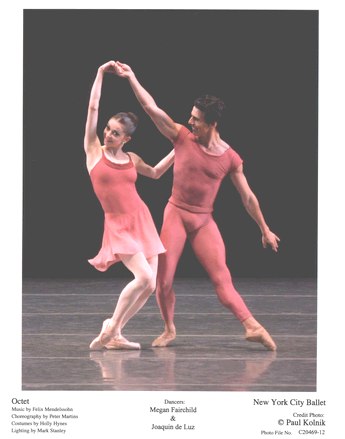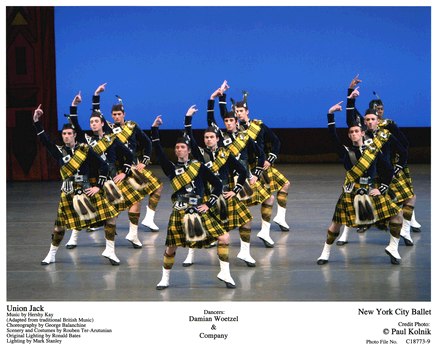|
 |
|
|
 |
 |
About the Author:
 New York City Ballet: Octet, In the Night, Union JackNew York City Ballet
www.nycb.org
Founders, George Balanchine and Lincoln Kirstein
Founding Choreographers, George Balanchine and Jerome Robbins
Ballet Master in Chief, Peter Martins
Ballet Mistress, Rosemary Dunleavy
Children's Ballet Mistress, Garielle Whittle
Orchestra, Music Director, Andrea Quinn
Managing Director, Robert Daniels
Associate Director, Communications, Siobhan Burns
Press Coordinator, Joe Guttridge
New York State Theater, Lincoln Center
(See Other NYC Ballet Reviews)
Dr. Roberta E. Zlokower
February 8, 2006
Octet (2003): (See January 29, 2005 Review). Music by Felix Mendelssohn (Octet in E-flat for Strings, Op. 20, 1885), Choreography by Peter Martins, Costumes by Holly Hynes, Lighting by Mark Stanley, Violins: Arturo Delmoni, Michael Roth, Yevgenia Strenger, Yeojin Cho, Violas: Maureen Gallagher, Laurance Fader, Celli: Fred Zlotkin, Eugene Moye, Performed by Megan Fairchild, Sara Mearns, Joaquin de Luz, Jonathan Stafford, Antonio Carmena, Aaron Severini, Sean Suozzi, Tyler Angle, Adrian Danchig-Waring, Christian Dvorzyanski. Mr. Martins, Artistic Director of NYC Ballet, champions contemporary music and choreographs widely for numerous ballets repertoires. (Program Notes).
Some ballets seem to grow in interest, and Octet is one that I find more thought-provoking this year. Two ensembles dance, either two males, two females, or the larger all male ensemble, and back together once more, in pastels of pink and green, thanks to Holly Hynes' unique leotards (Peter Martins' costume choice, evoking Balanchine's signature simplicity). Mendelssohn's Octet is robustly performed by another ensemble, this one of strings, and the violins, violas, and celli create instrumental rhythms that merge with this buoyant ballet.
Sara Mearns is a dancer to watch, with presence and poise, and Joaquin De Luz literally seized the moment with aerial twists that defied gravity, his characteristically charged persona. Megan Fairchild is perfectly partnered with Mr. De Luz, and they fed off each other's wild spirit. Jonathan Stafford seemed a bit stiff in comparison. The ensemble of men was energized on its own and backed the leads with some lightning leaps.
In the Night (1970): (See January 17, 2003 Review) Music by Frédéric Chopin, Choreography by Jerome Robbins, Costumes by Anthony Dowell, Lighting by Jennifer Tipton, Pianist: Nancy McDill, Performed by Jenifer Ringer and Sébastien Marcovici, Rachel Rutherford and Tyler Angle, Sofiane Sylve and Charles Askegard.
If In the Night were on every single program, it would not be too much. This is quintessential Robbins and quintessential City Ballet. Three couples emerge from the dark forest to four of Nancy McDill's effectively performed Chopin Nocturnes in passionate love, desire, or ambivalence, and each and every muscle seems involved in some of the most romantic ballet ever created. The golds of Sofiane Sylve's and Charles Askegard's scintillating costumes (thanks to Anthony Dowell) literally glow in the night, and the tiny lights, as stars or chandeliers, peek through the black backdrop in incredible reality (thanks to Jennifer Tipton). The other flowing, long dresses (I was too magnetized to take detailed notes on costume color) are so magically conceived, especially with the upside-down lifts and legs kicking with passion.
Jenifer Ringer and Sebastien Marcovici were theatrical and thrilling. Mr. Marcovici's regal stature is always a delight, and here his sideward head, in mock self-absorption, added to the poignancy of the performance. Ms. Ringer's character was strong and self-willed, but yielding to her lover. Rachel Rutherford and Tyler Angle were both swept up with the music and melodrama and danced to perfection. But, it was Ms. Sylve, partnered by Mr. Askegard, who offered the show-stopping segments, and Ms. Sylve's edgy intensity did her well in this dance of the heat of passion in the coolness of nighttime. Robbins' decision to have the three males, as well as the three females meet, in public politeness, and then latch once again onto their respective partners, for elegant togetherness, added flourish to the finale.
Kudos to Jerome Robbins, and kudos to Nancy McDill, as she sat at far left stage and had to peer into the darkness to time the beginning of each Nocturne. Her piano performance was noteworthy in its own right.
Union Jack (1976): (See June 19, 2005 Review). Music by Hershy Kay (Adapted from Traditional British Music), Music commissioned by New York City Ballet, Choreography by George Balanchine, Scenery and Costumes by Rouben Ter-Arutunian, Original Lighting by Ronald Bates, Lighting by Mark Stanley, Performed by Benjamin Millepied, Damian Woetzel, and male Company as Scottish and Canadian Guards Regiments, Lennox and Dress MacLeod, by Abi Stafford and female Company as Green Montgomerie, by Philip Neal and male Company as Menzies, by Yvonne Borree and female Company as Dress MacDonald, by Wendy Whelan and female Company as MacDonald of Sleat, by Teresa Reichlen and female Company as RCAF, by Nilas Martins, Jenifer Ringer, Brett Fukuda, and Lieneke Matte in Costermonger Pas de Deux, by Jason Fowler, Wendy Whelan, Adam Hendrickson, Damian Woetzel, Yvonne Borree, Benjamin Millepied, Abi Stafford, Philip Neal, and the Company as Royal Navy, and by Teresa Reichlen and female Company as Wrens.
"Union Jack" was designed by Balanchine as a tribute to the British heritage of America in the Bicentennial year of 1976. With Scottish military marches, British Music Hall entertainment, British Navy jigs, and Royal Navy drills and hand flags, Union Jack is Balanchine's ballet gift to a national historical moment. (Program Notes).
This one ballet is literally a show in itself, with at least seven segments, an everlasting percussive rhythm, a multitude of colorful tartans in kilts and caps, men in boots and women in toe shoes, a vaudeville act with a live donkey, short sailor skirts and long sailor bellbottoms, a sailing vessel in the background, hand flag signaling, a large British flag in the backdrop, and even the bursts of cannons. Union Jack is a must-see ballet for all ages. The last time I had seen Union Jack was at Jock Soto's farewell event, and this was his final dance. At that time, I was concentrating on Mr. Soto and not on the complexity of the staging.
On this viewing, as on the first, I focused on the split-timed choreography, as rows upon rows of Scottish and Canadian Guard Regiments in various combinations of black, red, green, and yellow tartans march forward, backward, sideward, or leap about inside a circle of marching regiments. Both Benjamin Millepied and Damian Woetzel made eye contact, as they filed their troops in unison or danced with bravura energy in the interludes. The Green Montgomerie Regiment, as well as Menzies and Dress MacDonald, followed by MacDonald of Sleat, brought an air of British patriotism to Balanchine's 1976 Bicentennial salute.
Philip Neal, Yvonne Borree, and Wendy Whelan seemed delighted and driven in the leadership and entertainment of their troops. Teresa Reichlen, one of the most mesmerizing of City Ballet dancers, was stunning as leader of the Royal Canadian Air Force. Her short white skirt and long limbs led her magnificent ensemble of nine RCAF dancers, as they flirted to the orchestra's whistles in their brief, white suits. As if the regiments and whistling orchestra were not enough, Balanchine added the vaudeville pair (Pearly King and Pearly Queen) in shiny-studded black suits, with a cane that hooks the neck and a live donkey that wheels in two children (Pearly Princesses).
Nilas Martins and Jenifer Ringer as "King" and "Queen" were, as always, well matched for size and physicality, as well as strong-willed theatrics and audience engagement. They entertained the audience, and, it seemed, each other, as well. There's a mock play-within-a-play, where Mr. Martins dashes offstage to pursue an ingénue, leading Ms. Ringer to empty a flask, but, as in vaudeville, the mistaken moment is corrected, and love is not lost. This comedic passage is followed by the Royal Navy in navy bellbottoms and caps, and Adam Hendrickson is especially electrified in his lightning spins. Damian Woetzel re-appears in the lead, as do Wendy Whelan, Benjamin Millepied, Philip Neal, Abi Stafford, and Yvonne Borree, having earlier led the regiments in kilts, with the addition of Jason Fowler and Mr. Hendrickson.
Teresa Reichlen radiantly returned with the WRENS (Women's Royal Naval Service), and the full company was onstage for the hand flag signals in an homage to British royalty, spelling "God Save the Queen". On every level, Union Jack is a masterpiece. Kudos to Hershy Kay for his arrangements of this mélange of memorable music, and kudos to George Balanchine.

Megan Fairchild and Joaquin De Luz in Octet
Photo courtesy of Paul Kolnik

Damian Woetzel and Company in Union Jack
Photo courtesy of Paul Kolnik
|
|
|




